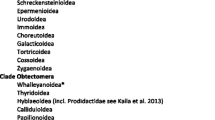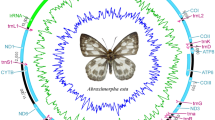Summary
Enzyme electrophoretic data show a remarkably high degree of genetic similarity within the European group ofnapi s.l. whereas genetic differences exist at several loci between the European and the North American taxa ofnapi s.l. It is concluded that the European taxa did not differentiate to the species level and form a phylogenetically young group. The North American taxa included in this study are specifically distinct from Europeannapi and separated much earlier. Within these North American taxamarginalis, oleracea andvirginiensis did undergo speciation. The data show a splitting of the genusPieris into three species groups, each genetically differentiated to the same level. The splitting ofPieris into two genera, as suggested by earlier investigators, is not supported here.
Similar content being viewed by others
Literatur
Acknowledgments. We are indebted to the following persons who sent living material: Dr K. Aagard, D. Benyamini, F. Catzeflis, U. Eitschberger, J. Forsberg, Prof. R. Hauser, T. Hayasaka, P. Jaksic, Dr F. Kasy, Dr H. Katakura, Dr D. Murphy, Dr T. Racheli, J. Reichel, Prof. A. M. Shapiro, Dr G. Thomson, Prof. P. Vogel and O. Yoshiaki and others which are named in earlier publications. Comments and suggestions of Prof. A. M. Shapiro and D. C. Webb considerably helped to improve the manuscript. This study has been supported by grants from the Swiss National Science Foundation (No. 3.640.80), Hochschulstiftung der Universität Bern and Dr Karl Bretscher-Stiftung Bern. We acknowledge the technical assistance of Mrs L. Frauchiger and V. Siegfried. Prof. R. Hauser continuously encouraged these studies.
Avise, J. C., Systematic value of electrophoretic data. Syst. Zool.23 (1974) 465–481.
Ayala, F. J., Tracey, C. A., Hedgecook, D., and Richmond, R. C., Genetic differentiation during speciation process inDrosophila. Evolution28 (1974) 576–592.
Bernardi, G., Revision de la classification des espèces holaretiques des genresPieris Schr. etPontia Fabr. Miscenea ent.44 (1947) 65–79.
Bowden, S. R., Hybrids within the EuropeanPieris napi L. species group, Proc. S. Lond. ent. nat. Hist. Soc. (1956) 135–159.
Bowden, S. R., ‘Sex-Ratio’ inPieris hybrids. J. Lepid. Soc.20 (1966) 189–196.
Bowden, S. R.,Pieris napi L. (Pieridae) and the superspecies concept. J. Lepid. Soc.26 (1972) 170–173.
Eitschberger, U., Zur Frage der Hybridnatur vonPieris napi (L.) mitbryoniae O. im nichtalpinen Raum. Atalanta4 (1972) 3–14.
Eitschberger, U., Die nordamerikanischen Arten aus derPieris napi-bryoniae Gruppe (Lep., Pieridae). Atalanta11 (1981) 366–371.
Ferguson, A., Biochemical systematics and evolution. Blackie, Glasgow and London 1980.
Ferris, C. D., and Brown, F. M., Butterflies of the Rocky Mountain states. University of Oklahoma Press, Norman, Oklahoma 1981.
Fitch, W. M., Molecular evolutionary clocks, in: Molecular Evolution, p. 160–178. Ed. F. J. Ayala. Sinauer Ass., Massachusetts 1976.
Forster, W., and Wohlfahrt, T., Die Schmetterlinge Mitteleuropas, 2. Tagfalter. Franckh, Stuttgart 1976.
Geiger, H. J., Enzyme electrophoretic studies on the genetic relationships of Pierid butterflies (Lepidoptera: Pieridae) I. European Taxa. J. Res. Lepid.19 (1981) 181–195.
Geiger, H. J., Biochemisch-genetische Untersuchungen zur Systematik und Evolution von Weisslingen des europäischen Faunengebietes (Lepidoptera, Pieridae). PhD Thesis, University of Berne 1982.
Geiger, H. J., and Scholl, A., Enzyme electrophoretic approach to the systematics and evolution of the butterflyEuchloe ausonia. Experientia38 (1982) 927–928.
Geiger, H. J., and Scholl, A.,Pontia daplidice (Lepidoptera, Pieridae) in Südeuropa-eine Gruppe von zwei Arten. Mitt. Schw. ent. Ges.55 (1982) 107–114.
Higgins, L. G., The classification of european butterflies. Collins, London and Glasgow 1975.
Hiura, I., An outline of the genusPieris. Acta Rhopalocerologica. Osaka Museum of Natural History, 1979.
Howe, W. H., ed., The butterflies of North America. Doubleday, New York 1975.
Klots, A. B., A generic revision of thePieridae (Lepidoptera). Ent. Am.12 (n.s.) (3–4) (1931/32) 139–242.
Kudrna, O.,Artogeia Verity, 1947, Gen. rev. forPapilio napi Linnaeus (Lep., Pieridae). Ent. Gazette25 (1974) 9–12.
Leraut, P., Liste systématique et synonymique des lépidoptères de France, Belgique et Corse. Alexanor (Suppl.), Paris 1980.
Lorkovic, Z., Semispecies a necessary new taxonomic category. Biol. Glasnik7 (1953) 236–237.
Lorkovic, Z., The genetics and reproductive isolating mechanisms of thePieris napi-bryoniae group. J. Lepid. Soc.16 (1962) 5–19 and 105–127.
Lorkovic, Z., Karyologischer Beitrag zur Frage der Fortpflanzungsverhältnisse südeuropäischer Taxone vonPieris napi (L.) (Lep., Pieridae). Biol. Glasnik21 (1968) 95–136.
Lorkovic, Z., Types of hybrid sterility in diurnal Lepidoptera speciation and taxonomy. Acta ent. Jug.14 (1978) 13–24.
Miller, L. D., and Brown, F. M., A catalogue/checklist of the butterflies of America north of Mexico. The Lepidopterists' Society. Memoir No. 2, 1981.
Müller, L., and Kautz, H.,Pieris bryoniae O. andPieris napi L. Österr. ent. Ver., Wien 1939.
Nei, M., Genetic distance between populations. Am. Nat.106 (1972) 283–292.
Nei, M., Estimation of average heterozygosity and genetic distance from a small number of individuals. Genetics89 (1978) 583–590.
Nei, M., and Roychoudhury, A. K., Genetic variation within and between the three major races of man, Caucasoids, Negroids and Mongoloids. Am. J. human Gen.26 (1974) 421–443.
Petersen, B., Geographische Variation vonPieris (napi) bryoniae durch Bastardierung mitPieris napi. Zool. Bidr. Upps.30 (1955) 355–397.
Petersen, B., Breakdown of differentiation betweenPieris napi L. andPieris bryoniae Ochs. and its causes. Zool. Bidr. Upps.35 (1963) 205–262.
Scholl, A., Corzillius, B., and Villwock, W., Beitrag zur Verwandtschaftsanalyse altweltlicher Zahnkarpfen der Tribus Aphaniini (Pisces, Cyprinodontidae) mit Hilfe elektrophoretischer Untersuchungsmethoden. Z. zool. Syst. Evolut.-forsch.16 (1978) 116–132.
Selander, R.K., and Johnson, W. E., Genetic variation among vertebrate species. A. Rev. ecol. Syst.4 (1973) 75–91.
Shapiro, A. M., The biological status of nearctic taxa in thePieris protodice-occidentalis group (Pieridae). J. Lepid. Soc.30 (1976) 289–300.
Shapiro, A. M., Genetic incompatibility betweenPieris callidice andPieris occidentalis nelsoni: differentiation within a periglacial relict complex (Lepidoptera: Pieridae). Can. Ent.112 (1980) 463–468.
Skibinski, D. O. F., Cross, T. F., and Ahmad, M., Electrophoretic investigation of systematic relationships in the marine musselsModiolus modiolus L.,Mytilus edulis L., andMytilus galloprovincialis Lmk (Mytilidae; Mollusca). Biol. J. Linn. Soc.13 (1980) 65–73.
Talbot, The Fauna of British India, Butterflies I, (1939) 416–417.
Thorpe, J. P., The molecular clock hypothesis: Biochemical Evolution, Genetic differentiation and Systematics. A. Rev. ecol. Syst.13 (1982) 139–168.
Varga, Z., Populationsstudien überPieris bryoniae O. im Karpathenbecken. I. Acta Biol. Debrecina5 (1967) 139–151.
Varga, Z., and Toth, I., Übersicht der taxonomischen und chorologischen Verhältnisse in derPieris (Artogeia) napi-bryoniae-Gruppe (Lep.: Pieridae) mit Rücksicht auf die Anwendung des Superspeciesbegriffes in der Lepidopteren-Taxonomie. Acta Biol. Debrecina15 (1978) 297–322.
Verity, R., Le farfalle diurne d'Italia, vol. III. Fierence 1947.
Warren, B. C. S., The androconial scales and their bearing on the question of speciation in the genusPieris (Lepidoptera). Ent. Ts. Arg.82 (1961) 121–148.
Warren, B. C. S., On the Nearctic species of thebryoniae andoleracea-groups of the genusPieris. Ent. Rec.80 (1968) 61–66.
Yang, S. Y., Soulé, M., and Gorman, G. C.,Anolis lizards of the eastern Caribbean: a case study in evolution. 1. Genetic relationships, phylogeny, and colonization sequence of the Roquet group. Systematic Zoology,23 (1974) 387–399.
The origin of the North AmericanPieris samples may be critical. We give here a list of the localities for these taxa. A complete list with the sampling sites for all taxa is available from the authors upon request:P. marginalis: Cascade Head, Lincoln Co, Oregon; Clearwater Valley, Idaho; Revelstoke, B. C.,P. marginalis mcdunnoughi: Gallatine Mtn, Montana; Goodrich Creak, Adams Co, Idaho.P. castoria: Gates Canyon, Solano Co; Lang Crossing, Nevada Co; American River Canyon, Placer Co, all California.P. oleracea: Vivian Forest, York Co, Ontario,P. virginiensis: Creekside, Indiana Co, Pennsylvania (2); Halton Co. Forest, Ontario.
Author information
Authors and Affiliations
Rights and permissions
About this article
Cite this article
Geiger, H.J., Scholl, A. Systematics and evolution of holarctic Pierinae (Lepidoptera). An enzyme electrophoretic approach. Experientia 41, 24–29 (1985). https://doi.org/10.1007/BF02005856
Published:
Issue Date:
DOI: https://doi.org/10.1007/BF02005856




